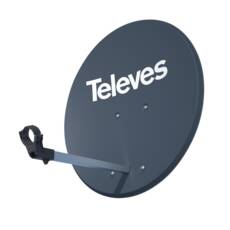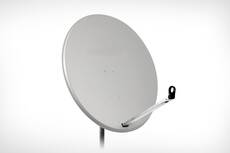Parabola Antennas
- further categoriesThere are many different types of satellites in space that can be used to send signals over long distances. Telecommunications satellites orbiting the Earth at a distance of 36 000 km can receive signals from parabolic antennas, which allow us to watch a wide range of TV channels. A satellite dish is in fact a satellite receiver, which can be used not only to receive TV broadcasts, but also to access radio programmes and other services such as the Internet. The system consists of the satellite receiver head, the indoor unit, the satellite dish and other accessories (cables, connectors, mounting brackets, etc.). But let's take a closer look at which one serves what purpose? Read more...
• Frequency range: 10.7-12.75 GHz
• Gain 11.7 GHz: 37.5 dBi
• LNB holder: 40
• Diameter of mast required for fixing: 32-60 mm
• Main material: galvanized steel (hot dip)
• Colour: RAL 7035 - Light grey
• Offset offset angle: 25.6 degrees
• 3 dB azimuth angle: 2.6 degrees
• Dimensions: 79 cm (height) x 71 cm (width)
• Net weight: 4,42 kg
• Material: Steel
• Reception Frequency: 10,70 - 12,75 Ghz
• Thickness: 0,5 mm
• Mount material: Plastic
• Dimension: 630x562 mm
• Weight: 1,69 kg
• Colour: Light grey, Dark grey
• Reflector Diameter: 600x531 mm
• Offset Degree: 27,77°
• Focal Lenght: 261 mm
• Satellite receiver head not included
• Antenna for satellite reception
• Reception Frequency: 10.70 - 12.75 GHz
• Material: Zinc Phosphated Steel
• Finish Coat: Polyester Powder Coating
• Color: Light Grey (RAL-7035)
• Small Axis Diameter: 71 cm
• Long Axis Diameter: 79 cm
• LNB Holder: 40 mm
• Operation Wind : 90 km/h
• Survial Wind: 150 km/h
• Antenna for satellite reception
• The mesh design allows for better wind resistance
• Reception Frequency: 10.70 - 12.75 GHz
• Material: Zinc Phosphated Steel
• Finish Coat: Polyester Powder Coating
• Thickness: 0,6 mm
• Small Axis Diameter: 71 cm
• Long Axis Diameter: 79 cm
• Operational Temperature: -40° + 60°
• Operation Wind: 90 km/h
• Survial Wind: 150 km/h Mount
Special gross price: 30.85€ (Net price: 24.29€)
• Antenna for satellite reception
• Longlife anti corrosive treatment
• Reception Frequency: 10.70 - 12.75 GHz
• Material: Zinc Phosphated Steel
• Finish Coat: Polyester Powder Coating
• Color: Light Grey (RAL-7035)
• Small Axis Diameter: 87 cm
• Long Axis Diameter: 97 cm
• LNB Holder: 40 mm
• Operation Wind : 90 km/h
• Survial Wind: 150 km/h
• Its large size allows it to receive several satellites with the appropriate LNB head
• Antenna for satellite reception
• The mesh design allows for better wind resistance
• Reception Frequency: 10.70 - 12.75 GHz
• Material: Zinc Phosphated Steel
• Finish Coat: Polyester Powder Coating
• Color: Light Grey (RAL-7035)
• Small Axis Diameter: 87 cm
• Long Axis Diameter: 97 cm
• LNB Holder: 40 mm
• Operation Wind : 90 km/h
• Survial Wind: 150 km/h
• Its large size allows it to receive several satellites with the appropriate LNB head
• Frequency range: 10-13 GHz
• Gain 11.7 GHz: 38,50 dBi
• LNB holder: 40/23
• Mast diameter required for fixing: 30-90 mm
• Main material: aluminum
• Colour: RAL 7035 - Light grey
• Offset offset angle: 21,1 degrees
• -3 dB azimuth angle: 1,95 degrees
• Dimensions: 85 cm (height) x 90,5 cm (width)
• Wind-load (120 km/h): 75 kg
• Net weight: 5,4 kg
• Frequency range: 10-13 GHz
• Gain 11.7 GHz: 39,70 dBi
• LNB holder: 40/23
• Mast diameter required for fixing: 30-90 mm
• Main material: aluminum
• Colour: RAL 7035 - Light grey
• Offset offset angle: 21 degrees
• -3 dB azimuth angle: 1,7 degrees
• Dimensions: 97 cm (height) x 100,4 cm (width)
• Wind-load (120 km/h): 98 kg
• Net weight: 7,1 kg
• Frequency range: 10-13 GHz
• Gain 11.7 GHz: 39,70 dBi
• LNB holder: 40/23
• Mast diameter required for fixing: 30-90 mm
• Main material: galvanized steel
• Colour: RAL 7035 - Light grey
• Offset offset angle: 21 degrees
• -3 dB azimuth angle: 1,7 degrees
• Dimensions: 97 cm (height) x 100,4 cm (width)
• Wind-load (120 km/h): 98 kg
• Net weight: 10,5 kg
• Frequency range: 10.7-12.75 GHz
• Gain 11.7 GHz: 39.5 dBi
• LNB holder: 40/60
• Mast diameter required for fixing: 32-60 mm
• Main material: galvanized steel (hot dip)
• Colour: RAL 7035 - Light grey
• Dimensions: 97 cm (height) x 87 cm (width)
• Offset offset angle: 26.37 degrees
• 3 dB azimuth angle: 2.0 degrees
• Net weight: 6.5 kg
• Frequency range: 10.7 - 12.75 Ghz
• Material: Aluminium
• Gain: 35.5 dBi
• Offset angle: 26.2
• Dish size: Height 637 mm , weight 575
• Stainless steel reflector and screws
• Adjustable elevation angle from 0º to 90º
• An hex wrench is integrated in the LNB support itself for nut adjustment
• LNB-bracket diameter: 40 mm
• Colour: grey
• Frequency range: 10.7 - 12.75 Ghz
• Material: aluminium
• Gain: 38 dBi
• Offset angle: 26.2
• Dish size: Height 833 mm , weight 747
• Stainless steel reflector and screws
• Adjustable elevation angle from 0º to 90º
• An hex wrench is integrated in the LNB support itself for nut adjustment
• LNB-bracket diameter: 40 mm
• Colour: white
- Low Noise Block, often referred to by professionals as LNB, which is short for Low Noise Block, this unit is the actual receiving element of the SAT antenna.
- Indoor satellite receiver unit, which converts signals into a form that can be displayed on television.
- Parabolic mirror, whose function is to concentrate the signals into a focal point.
- Other accessories, perhaps one of the most important details is the proper cabling, the signals are transmitted via coaxial cable.
Nowadays, satellite dishes are offset antennas. This refers to the parabolic mirror, nowadays we mostly see such satellite antennas. In contrast to the rotationally symmetric dishes used in the past, today's offset satellite systems are no longer necessarily circular, but have oval shapes. Digital satellite receivers can receive both encrypted and unencrypted digital transmissions.
Why are satellite dishes so popular?
The popularity of satellite television is unbroken in our country. With the help of satellite TV, the number of TV channels available is much greater, and you can watch channels that are not available through your cable provider. With a satellite dish, you have a much better view of what is happening in the world. But if you are learning a language, for example, it's also a great help because you can listen to and watch films, programmes and news in that language.
Types of satellite dishes
The classic satellite dish has a prime focus mirror. These are round direct focus antennas with the focal point on the axis of symmetry. But one can also encounter reticulated satellite antennas with a larger dish for telecommunications purposes. These should not be confused with the mesh design, but more on that in a moment. But as we have already mentioned, today's satellite receivers are offset antennas. In this case, the antenna is no longer pointed directly at the satellite, but is set at a certain offset angle.
There are also flat satellite antennas, which are small and practical. They are designed for caravans, camping or for use on balconies. They are portable satellite dishes, also used by truckers. They are not as efficient as the classic circular models. In their case, the weather can have a greater impact on their image, video and sound quality. But there are also heated satellite dishes, used mainly by TV studios.
What size satellite dish to choose?
The size of the satellite dish determines how good the reception quality of the channels is, i.e. the sensitivity of the dish depends mostly on the size of the parabolic mirror. Make sure that the dish size is appropriate if the diameter is at least ten times the wavelength. In our country, this means an average width of 2.5 cm, i.e. the minimum diameter of a parabolic mirror is at least 25 cm. When buying a satellite dish for your home, you can choose between 40 and 120 cm mirrors. There are also plates with diameters of 60, 80, 85 and 100 cm. Smaller antennas are used as mobile satellite systems because they take up less space. They are most commonly found in motorhomes. Larger dishes are used for industrial, telecommunications, governmental purposes.
For domestic use, choose parabolic antennas with a diameter of 60 cm or more.From this size onwards, reception is considered reliable. As the weather can have a major influence on the quality of reception, it is advisable to determine the size of the mirror by using a ratio. Remember that if the signal strength is weak, clouds or snowfall may even prevent reception. There is one more important detail to pay attention to, and that is the quality of the parabolic mirror. A mirror with a smooth, undamaged surface can only provide a good quality signal. The dish itself can be made of steel, galvanised steel or aluminium, but mobile antennas are mostly made of aluminium.
What to look out for when mounting a satellite dish?
A satellite dish can be mounted using a mast or a wall bracket.A wall bracket is screwed to the wall with 4 screws and universal dowels. Make sure that the parabolic reflector is properly fixed and can be moved at the same time, i.e. the antenna can be easily adjusted over a wide range of angles, but at the same time it must be able to withstand strong wind gusts, i.e. it must be resonance-free. The effect of wind, especially on larger antennas, should be taken very seriously. As we know, the satellite receiver head is aligned with the focal point, so we have to be very careful about its exact position. If the mounting arm is out of alignment, reception can be greatly degraded or even lost.
Where to place the satellite dish?
When installing a satellite dish, a few things need to be considered, such as making sure that reception of the broadcast is razor sharp and that the parabolic mirror itself is stable in a storm. In the case of family houses and condominiums, the antennas are usually placed on the roof by professionals. The roof of the house is often chosen because it far outweighs the elimination of potential distractions such as other houses or trees. But remember that the weather can still interfere with reception. Therefore, house walls are now used for this purpose in many cases. However, this also has the advantage that mounting on a house wall is not as dangerous, and you can even reach the antenna faster if you need to repair it.
Nowadays, you can also buy parabolic antennas with a mesh design, which have a hole structure for better wind resistance, but a gust of wind can still hit this type. Mesh dishes are also an advantage in locations where good light transmission is important. Therefore, this type of plate should be placed primarily in a location where it would block a lot of light, such as on a balcony. If you are not placing the satellite dish on the building, but next to it, make sure that you ground the device in this case.
Our company offers a wide range of satellite dish satellite dishes. If you have any questions about which antenna is right for you, please contact us!












